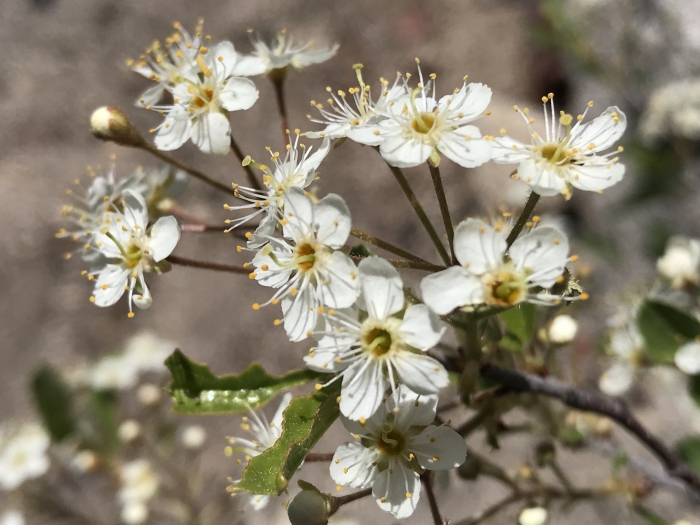Bitter Cherry
(Prunus emarginata)
Bitter Cherry (Prunus emarginata)
/
/

© rappman
CC BY 4.0
Image By:
© rappman
Recorded By:
Copyright:
CC BY 4.0
Copyright Notice:
Photo by: © rappman | License Type: CC BY 4.0 | License URL: http://creativecommons.org/licenses/by/4.0/ | Uploader: rappman | Publisher: iNaturalist |






















































Estimated Native Range
Summary
Prunus emarginata, commonly known as Bitter Cherry, is a deciduous tree or shrub native to the Pacific Northwest of North America, including the western United States and British Columbia. It is often found in moist forests, along streams, and in clearings or on the edges of woodlands. This species typically grows 1–15 meters (3½–49 feet) tall and features a slender oval trunk with smooth gray to reddish-brown bark adorned with horizontal lenticels. The leaves are oval with a pointed tip and finely toothed margins. The flowers are small, 10–15 millimeters (3/8–5/8 inch) in diameter, with five white petals and numerous hairlike stamens; they emit an almond scent, bloom in clusters in the spring, and are insect-pollinated. The fruit is a red or purple cherry, 7–14 mm (1/4–1/2 inch) in diameter, which is bitter to taste.
Bitter Cherry is valued for its springtime floral display and its ability to form natural thickets, providing habitat for wildlife. It is used for restoration projects, as a background plant in native plant gardens, and for erosion control due to its spreading habit. It thrives in a range of light conditions from full sun to full shade and prefers moist, well-drained soils. While it is not a common choice for urban planting due to its suckering nature, it can be managed in a naturalized setting. Gardeners should be aware that the plant can spread aggressively through its underground stems. The bitter cherries, while not palatable for humans, are an important food source for birds and other wildlife.CC BY-SA 4.0
Bitter Cherry is valued for its springtime floral display and its ability to form natural thickets, providing habitat for wildlife. It is used for restoration projects, as a background plant in native plant gardens, and for erosion control due to its spreading habit. It thrives in a range of light conditions from full sun to full shade and prefers moist, well-drained soils. While it is not a common choice for urban planting due to its suckering nature, it can be managed in a naturalized setting. Gardeners should be aware that the plant can spread aggressively through its underground stems. The bitter cherries, while not palatable for humans, are an important food source for birds and other wildlife.CC BY-SA 4.0
Plant Description
- Plant Type: Tree, Shrub
- Height: 7-50 feet
- Width: 15-25 feet
- Growth Rate: Moderate
- Flower Color: White
- Flowering Season: Spring
- Leaf Retention: Deciduous
Growth Requirements
- Sun: Full Sun, Part Shade, Full Shade
- Water: Medium
- Drainage: Medium, Slow
Common Uses
Bee Garden, Bird Garden, Butterfly Garden, Erosion Control, Fire Resistant, Fragrant, Hummingbird Garden, Low Maintenance, Rabbit Resistant, Showy Flowers
Natural Habitat
Moist forests, along streams, and woodland edges
Other Names
Common Names: Oregon Cherry
Scientific Names: , Prunus emarginata, Prunus emarginata var. emarginata, Prunus trichopetala, Cerasus emarginata, Prunus crenulata, Prunus padifolia, Prunus prunifolia, Cerasus kelloggiana, Prunus emarginata var. villosa
GBIF Accepted Name: Prunus emarginata (Douglas ex Hook.) Walp.